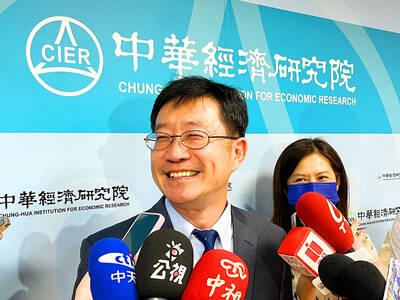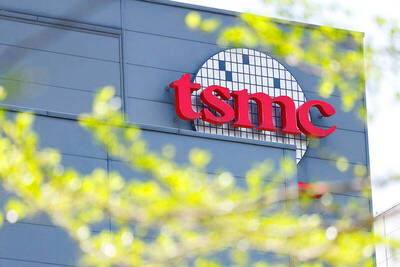“The difference between the Guizhou of today and when I was young is huge,” said 56-year-old Li Maoqin, a resident in the southwestern Chinese province’s capital, Guiyang. “It’s like the difference between the earth and the sky.”
Guiyang, nestled among luscious green mountain peaks, has typically been known more for poverty than innovation. As a child, Li was so poor she went with her grandmother from village to village, begging for food.
However, the rapidly developing city has a plan to reinvent itself as a technology hub, attracting thousands of tech-savvy entrepreneurs to a week-long expo, drawing big names to open data centers and embracing the self-proclaimed nickname “China’s big data valley.”

Photo: Reuters
While China’s growth has generally been powered by top-tier eastern cities, Guizhou last year posted the third-fastest economic growth among China’s 31 provinces and Guiyang was last year ranked as the best-performing city by the Milken Institute.
“If you have missed the investment opportunity in Guangdong or Zhejiang 30 years ago, by no means should you miss that of Guizhou today,” Alibaba Group Holding Ltd (阿里巴巴) chairman Jack Ma (馬雲) said.
An hour’s drive out of Guiyang is Gui An New District, a 1,795km2 suburb designated as the strategic heart of Guiyang’s technology aspirations.
A new Foxconn Technology Group (富士康科技集團) plant is among the first to open here, packed with hundreds of young employees brandishing smartphones and ID tags.
The center sits beside a newly built road lined with cars and bicycles in a newly built industrial park — Gui An’s public transport has yet to be built.
While Foxconn is among the first to arrive, more are coming. Tax incentives, state support and lower costs have helped draw companies, including Microsoft Corp, Huawei Technologies Co (華為), Hyundai Motor Co, Tencent Holdings Ltd (騰訊), Qualcomm Inc and Alibaba, to Guiyang.
A partnership with India’s NIIT for a Professional College of Electronics has been agreed, and a Chinese-UK data park of 30 companies are to jointly develop health technology.
The government has projected that investment into Gui An will increase by 11 percent to US$3.34 billion this year and create 30,000 jobs.
This marks a change from the established pattern of economic growth in China, which has been overwhelmingly based around the eastern growth corridor through Beijing, Shanghai, and the southern cities of Shenzhen and Guangzhou — Shanghai alone has been growing at an average annual rate of about 10 percent for the past 20 years.
However as populations have soared, so have costs, and the relative affordability of western China is increasingly appealing.
The third China Big Data Industry Expo in May was the latest opportunity to market Guiyang’s benefits.
This year, Alibaba announced it will launch a block data center with the Guiyang Public Security Bureau, while Tencent showcased augmented-reality hong bao and Hydata Software Co Ltd unveiled lip-reading recognition tech.
Although big data investment into Guizhou almost doubled last year, the landlocked province’s growth is also down to much-needed infrastructure. Guiyang has a modern railway station and international airport, with another 10,000km of highway and 4,000km of train tracks planned to be completed by 2020.
Programs to improve housing last year saw 458,000 people resettled into new homes, and the government said it lifted 1.2 million Guizhou residents out of poverty last year alone.
As a growing city, Guiyang is also showing some success in drawing in young talent.
Xiaoxiao Pan, a lecturer at Guizhou Normal University, said he originally moved back to Guiyang from Shanghai to be with his ill father, but decided he liked the lifestyle and stayed.
“Even compared with two years ago, there are many new companies going public, familiar brands, shopping malls, tall buildings,” he said.
Housing is cheap, at about 2,000 yuan (US$295) per month for a central apartment, while comparatively fresher air and the lush surrounding countryside also have appeal.
Taiwanese teacher Jerry Xie chose a job in Guiyang over Beijing because of pollution concerns and affordability.
“The salaries now are similar to Beijing, where the air sucks, and the cost of living here is much cheaper and they are eager for talented people,” he said.
However, there is much to be done in the rebranding of Guiyang. Gui An New District is an enormous building site marooned in surrounding countryside.
A survey put Guiyang in the top 10 worst Chinese cities for traffic. The skyline is dominated by cranes and roadworks, particularly around the Guizhou financial city district.
However, as the urban fabric of Guiyang changes under their feet, locals do not mind the roadworks and construction.
Finally, their city is going places.

WEAKER ACTIVITY: The sharpest deterioration was seen in the electronics and optical components sector, with the production index falling 13.2 points to 44.5 Taiwan’s manufacturing sector last month contracted for a second consecutive month, with the purchasing managers’ index (PMI) slipping to 48, reflecting ongoing caution over trade uncertainties, the Chung-Hua Institution for Economic Research (CIER, 中華經濟研究院) said yesterday. The decline reflects growing caution among companies amid uncertainty surrounding US tariffs, semiconductor duties and automotive import levies, and it is also likely linked to fading front-loading activity, CIER president Lien Hsien-ming (連賢明) said. “Some clients have started shifting orders to Southeast Asian countries where tariff regimes are already clear,” Lien told a news conference. Firms across the supply chain are also lowering stock levels to mitigate

IN THE AIR: While most companies said they were committed to North American operations, some added that production and costs would depend on the outcome of a US trade probe Leading local contract electronics makers Wistron Corp (緯創), Quanta Computer Inc (廣達), Inventec Corp (英業達) and Compal Electronics Inc (仁寶) are to maintain their North American expansion plans, despite Washington’s 20 percent tariff on Taiwanese goods. Wistron said it has long maintained a presence in the US, while distributing production across Taiwan, North America, Southeast Asia and Europe. The company is in talks with customers to align capacity with their site preferences, a company official told the Taipei Times by telephone on Friday. The company is still in talks with clients over who would bear the tariff costs, with the outcome pending further

Six Taiwanese companies, including contract chipmaker Taiwan Semiconductor Manufacturing Co (TSMC, 台積電), made the 2025 Fortune Global 500 list of the world’s largest firms by revenue. In a report published by New York-based Fortune magazine on Tuesday, Hon Hai Precision Industry Co (鴻海精密), also known as Foxconn Technology Group (富士康科技集團), ranked highest among Taiwanese firms, placing 28th with revenue of US$213.69 billion. Up 60 spots from last year, TSMC rose to No. 126 with US$90.16 billion in revenue, followed by Quanta Computer Inc (廣達) at 348th, Pegatron Corp (和碩) at 461st, CPC Corp, Taiwan (台灣中油) at 494th and Wistron Corp (緯創) at

NEGOTIATIONS: Semiconductors play an outsized role in Taiwan’s industrial and economic development and are a major driver of the Taiwan-US trade imbalance With US President Donald Trump threatening to impose tariffs on semiconductors, Taiwan is expected to face a significant challenge, as information and communications technology (ICT) products account for more than 70 percent of its exports to the US, Chung-Hua Institution for Economic Research (CIER, 中華經濟研究院) president Lien Hsien-ming (連賢明) said on Friday. Compared with other countries, semiconductors play a disproportionately large role in Taiwan’s industrial and economic development, Lien said. As the sixth-largest contributor to the US trade deficit, Taiwan recorded a US$73.9 billion trade surplus with the US last year — up from US$47.8 billion in 2023 — driven by strong